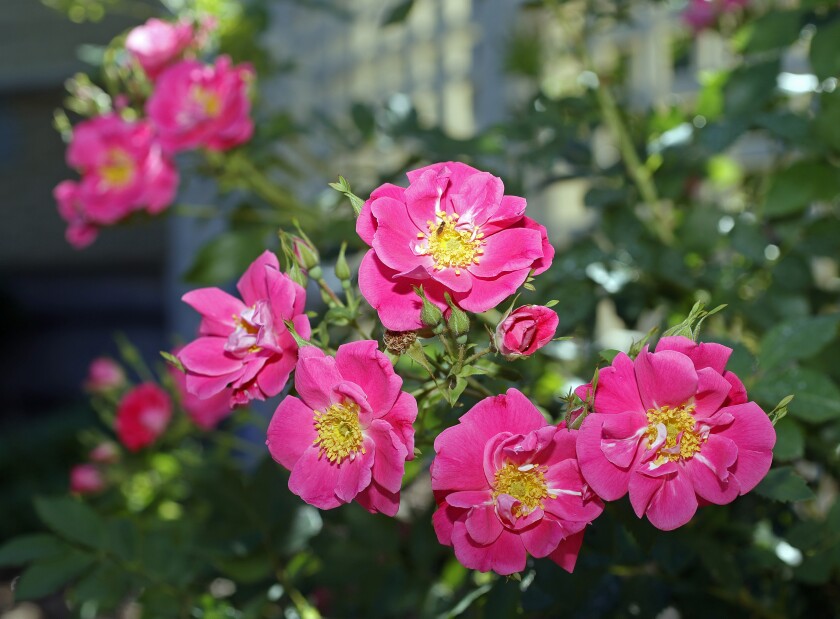FARGO — Most of us have heard of the White House Rose Garden, but do you know its origins? It was started in the early 20th century when a part of the property was no longer needed for horse stables with the advent of the newly invented automobile, and the area was developed into a formal rose garden.
June is officially designated as National Rose Month, and with good reason: It’s the month when rose bushes are at their finest. June is the flowering peak for most rose types, with smaller flushes of bloom through the rest of summer.
ADVERTISEMENT
I’m a big fan of roses, especially those that bloom delightfully without a lot of fuss. My wife, Mary, and I have a collection of 12 different cultivars of roses, and they survive winter beautifully, even without extra winter protection.

Roses can be confusing, because traditionally the types are divided into categories such as hybrid tea, grandiflora and floribunda. But my favorite rose classification is simple: winter-hardy and not winter-hardy.
“Hardy” is a relative term, and what’s hardy for Kentucky might not survive in the North country. If a rose tag says “winter-hardy,” it doesn’t necessarily apply to winters in North Dakota and Minnesota.
Many roses sold at national chains are not fully winter-hardy and are borderline for much of our region, including the Knockout series, Meidiland series, Carefree Beauty, Flower Carpet, Robin Hood, Simplicity, Freedom and Easy Elegance series. They’re best planted in a sheltered microclimate receiving good snow cover with protective mulch applied in fall. Most are rated for hardiness zones 4 to 5.
Winter-hardy roses
The following varieties, developed in Canada, are great choices to fill Northern rose gardens. They’re well-adapted, with hardiness ratings of zones 2 and 3. This is only a partial list, but it includes a few of our favorites.
- Canada Blooms: Fragrant pink flowers with hybrid tealike form.
- Never Alone: Vivid blossoms with deep red edges and a vibrant white center.
- Campfire: Indescribable tricolor of reddish-pink, yellow and white.
- Canadian Shield: Large red flowers.
- Bill Reid: Yellow.
- Oscar Peterson: Large, semi-double white.
- Cuthbert Grant: Crimson red double.
- Hope for Humanity: Double deep red.
- Morden Blush: Pink, blushing to ivory.
- Morden Belle: Pleasant pink; disease resistant.
- Morden Fireglow: Glowing red.
- Morden Snowbeauty: Very floriferous white.
- Morden Sunrise: Vivid yellow-orange.
- Winnipeg Parks: Medium red.
- J.P. Connell: Lemon yellow.
- John Cabot: Medium red.
- Quadra: Dark red.
- Pavement series: Purple, scarlet, white types.
- Henry Kelsey: Rosy-red. One of the best climbers.
- William Baffin: Rose-pink. Excellent climber.
- Other older hardy types: Hansa, Harrison’s Yellow, Therese Bugnet, Topaz Jewell and Wild Woods Rose.

Where can we find these roses? Locally owned garden centers are the best bets, as they’re more likely to be knowledgeable about these cultivars for Northern gardens. No garden center will have all these types, but usually offer a few of their favorites.
ADVERTISEMENT
Tips for growing roses
- Roses love soil high in organic material. Add generous amounts of peat moss at planting time and incorporate into soil.
- Potted roses can be planted all season, but planting by midsummer gives them more time to establish. Give late-planted roses protective mulch during the first winter.
- Plant the crown, where branches meet roots, at least 3 to 4 inches below soil surface for best winter survival.
- Roses bloom best with at least six hours of direct sun daily.
- Mulch soil around roses with 3 inches of shredded bark or cocoa bean mulch to keep soil cool and moist. Landscape rock is less preferable for roses, because of its tendency to trap heat.
- Roses thrive with good moisture. Avoiding wetting leaves to prevent foliage disease.

Campfire rose, developed in Canada, survives Northern winters with no additional protection. David Samson / The Forum - Products sold as rose dust or rose spray combine disease-preventing fungicides with insect control.
- Roses are heavy feeders. Fertilize monthly April through July for tremendous bloom.
- Trim off withered blossoms down to the first five-leaflet leaf below the flower, which results in a greater flush of new buds.
- Roses are sold “grafted” or “own root.” Own-root is preferred, because grafted roses are more susceptible to everything above the graft knob freezing out.
- Rabbits love consuming rose canes during winter, so add a fence of chicken wire in fall.
- If roses suffer winter rabbit injury or cane dieback, prune heavily in spring and the roses bounce back fine.
- Don’t prune roses in fall; wait until spring for best survival.
Don Kinzler, a lifelong gardener, is the horticulturist with North Dakota State University Extension for Cass County. Readers can reach him at donald.kinzler@ndsu.edu.











